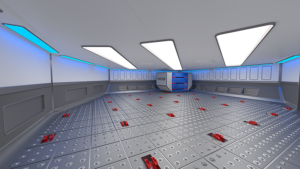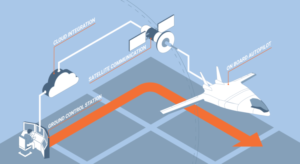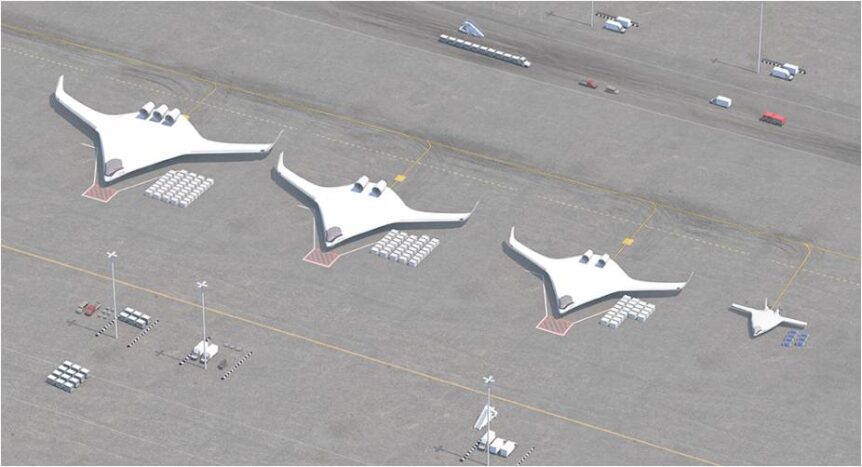ZeroAvia, maker of hydrogen-Electric powerplants for zero-emission aviation, has been selected to partner with Natilus, “a leading innovator in designing and developing new autonomous blended-wing-body (BWB) cargo aircraft.” Kona, smallest of the pack, will carry a 3.8-ton (7,600-pound), while Natilus’ web site shows three additional BWBs, jumping to 60, 100, and 130 tons cargo-carrying capacity and maximum takeoff weights of up to nearly a million pounds.
For a fact sheet on all the designs, click here.
As an option to conventional turboprops, two ZeroAvia’s ZA600s producing 600 kilowatts (804 horsepower) each will power Kona, with its 26-meter (85-foot) wingspan capable of carrying its load 900 nautical miles (1,667 kilometers) at a cruising speed of 220 knots (407 kilometers) per hour.
Natilus claims its range of BWB’s will 60-percent more cargo volume than traditional aircraft for the same weight giving 60-percent lower total cost of operations and 50-percent lower CO2 emissions.

Interior of Natilus Kona shows capacious interior with high volume and multiple tie-down points
In terms of operating costs, Natilus’ largest craft come in between air freight and ocean freight, equaling the 12 hours necessary to fly cargo from the West Coast to an Asian destination (or vice-versa). But, Natilus will cost only $130,000 for the trip compared to conventional air freight’s $216,000. Ocean freight of the same cargo would cost only $40,000 but take 21 days, often a crucial factor in getting commodities to market.
ZeroAvia’s Contribution
ZeroAvia’s ZA600 is a well-tested electric propulsion unit with eight successful flights on the company’s Dornier 228 test airplane in England. The latest, on May 18, took the test craft to 4,000 feet, “making it the highest flying commercial-scale aircraft powered by fuel cells,” according to the company.
The Dornier’s third test flight on April 6 saw the craft flying on only the left side’s ZeroAvia motor, the conventional turbine on the right side providing zero thrust. The ZA600 has gone through extensive ground tests on a mobile motor mount, and is continuing testing in both England and America. Certification is expected by 2025.
The ZA600 seems ideally suited to powering the Kona, but whether larger ZeroAvia powerplants will be able to suit the larger Natilus craft is an open question. ZeroAvia just signed “an expanded agreement with Mitsubishi’s Canada-based MHI RJ Aviation Group (MHIRJ) aimed at retrofitting CRJ Series aircraft with zero-emissions powertrains.” Will these types of propulsion units be scalable enough to provide globe-girdling capabilities?
That Tricky Unpiloted Part
Under the “Future Proofing” heading, Natilus explains, “Whether the flight operations warrant a FAA-certified UAV (Unpiloted Aerial Vehicle) or the aerospace regulations call for human pilot controls, Natilus offers the ultimate flexibility and solution to the pilot shortage or regulations that stagnate traditional airline growth.” Natilus’ “Fly-by-Mouse” system requires a ground control station with software that allows a single operator to fly three aircraft at once. Cloud-based integration will plot courses, communicate with the drones and other ground-based controllers. Dual-redundant satellite relays will provide a minimum of 700 kilobytes per second within the system, and on the aircraft themselves, dual-redundant autopilots will manage aircraft systems, communication, and flight.

Ground-based controller, satellites, and automated controls team to guide autonomous craft to its destination.
A Flying Wing Forbearer
Jack Northrop saw the evolution of his flying wing concept that became the XB-35 and YB-49 bombers into passenger and cargo-carrying long-range craft. The eventual creation of blend-wing bodies is an extension of what Northrop had in mind, and today’s increasingly clean propulsion alternatives provide hope for green skies ahead. With computerized, triple-redundant controls, newer aircraft will have controllability and stability that earlier airplanes lacked, and that doomed Northrop’s vision.

